Home › Forums › Questing › Questing Leads › Lost Writings of John the Evangelist
This topic contains 0 replies, has 0 voices, and was last updated by imported_Simon 18 years, 2 months ago.
-
AuthorPosts
-
February 22, 2006 at 11:03 pm #1703
This has been alluded to in my earlier background to the Icon Trail Quest ([url:24tnbovp]http://www.psychicquesting.com/ftopict-19.html[/url]) but let me give a little more detail here.
The story in a nutshell is that a Swiss visionary, Joa Bolendas, had a number of visions (since published in two volumes). A Benedictine monk in Ireland decided to act on these vions and built a chapel to house a number of significant Russian Orthodox Icons. This has created a place of power which works on a number of levels but one of the icons is particularly associated with helping people with cancer (my colleague’s wife, whom I mentioned in the earlier thread and who was only given weeks to live – who had in fact gone home to Australia to die – was yesterday “officially” declared in remission with a good chance that the brain tumour will not return – go figure!).
Anyway that is the main thrust of the quest but one of the sub-themes was that this same visionary also said that there were writings of John (who she believed was the same person as Lazarus) waiting to be discovered. I had taken it upon myself to chase this down but owing to the distraction of other things (like setting up this website, dealing with three children under the age of three
 ) I can’t say when I’m actually going to get a chance to follow this through.
) I can’t say when I’m actually going to get a chance to follow this through.So…here’s what I’ve got so far.
The exact quote is (from Joa Bolendas – So that you May be One):
John – was Lazarus – whom Jesus awoke from the dead. (p. 340)
Documents and writings of John
Lie by the straight street – in Ephesus.
They are records from his time with Jesus,
And from later times with the apostles.
They are important for you. (p. 356)Now initially that all sounded promising but it quickly turned out that the “famous” Straight Street is in Damascus, not Ephesus so that wasn’t encouraging for the accuracy of the information. However, when I queried it with my archaeological contact (PhD in Archaeology and currently lecturing in a major British Uni so who wishes to remain anonymous), I got the following response:
“Rather than doing what I should be doing concerning the really rather tedious late Roman Republic, I have been thinking about your Ephesus/Damascus streets. Street names are generally given to ancient cities by archaeologists and only on a few occasions are we provided with clues as to the original names. Pausanias (Roman travel writer) is pretty good at letting us know the names of streets, when there are any and they tend to be called after particular landmarks (such as temples/local cults). He does however, often refer to ‘the straight road’ when describing a number of different cities in Greece. At a quick glance these streets may (and I stress, may) refer to the main street which links the port to the town. So the fact that Damascus has a street called Straight Street may just be due to the possibility that there is an ancient source to this and the archaeologists have carried on the name. Whereas actually it seems that having a street named ’straight street’ might have been common for Greek/Roman cities and certainly not exclusive to Damascus. So it seems to me you should be fine with your straight street in Ephesus. What may be slightly problematic might be the fact that there were two cities of Ephesus, the Greco-Roman one being the latest in date and somewhat more inland than the original port foundation. “
So that was pretty promising. Now subsequently I received further intuitive material (not from Joa Bolendas) that suggested the writings were sealed in an amphora – or several amphorae – which had a large hooped handle underneath a smaller hooped handle on each side of the amphora (making four in total, but not the usual four evenly-sized and evenly spaced around the vessel). I could draw a (bad) picture but you probably get the idea. This amphora was part of a larger pile in an ancient taverna/taverna’s cellar by the side of this straight street. This taverna had possibly been partially excavated sometime in the past (so if this material has any validity then there may be some old record of such a building/cellar being discovered) but has now been reburied (although not deeply).
And that’s as far as I’ve got. It really needs (step 1) someone to see if there is any record of such a site being excavated in the past and if so (step 2) can it be refound and entered without bringing the Turkish authorities down on your head! Maybe a quick reality check would be to see if the distinctive style of clay amphora actually existed at that time.
Madness? Possibly. But also it could be one of the biggest finds of recent times.
Oh yes there was one interesting further article I found which linked John, Ephesus and wine (and snakes and wedding feasts but that’s a whole other quest!) which I found on a Catholic website:
“Q: From my position in the choir loft I am in a direct line of vision with a painting of St. John the Evangelist.
The painting depicts St. John holding a chalice with his right hand, and his left hand touching his chest. Out of the chalice is rising an unmistakable green snake! Its position is such that it looks as if the snake has just bitten or will bite St. John’s left hand.
Why does St. John have a snake in his chalice? I’ve asked many people, and nobody knows.A: In at least some religious houses on December 27, the Feast of St. John, the religious superior blesses wine which is then drunk at the meal. The old Roman Ritual contained a blessing of wine for this feast. This commemorates the legend that once, while at Ephesus, John was given a cup of poisoned wine to drink. Before drinking, he blessed the cup and the poison departed the cup in the form of a serpent.
According to Francis X. Weiser in the Handbook of Christian Feasts and Customs (Harcourt Brace), as late as 1952 Catholics in Central Europe brought wine and cider to church for blessing on the feast of St. John. They then took it home and some of them poured a bit of the blessed wine or cider into every barrel in the cellar.
The blessed wine is called by some the “love of St. John.” In some places the bride and groom at a wedding are given a sip to drink. In other cases a sip of the wine is given to a dying person as a sacramental.”
February 23, 2006 at 12:47 pm #1981Hmmm – maybe I should take this one back as it seems the Quest won’t let me go

I’m currently reading Labyrinth by Kate Mosse which is a “Da Vinci Code”-esque novel (although arguably better than TDVC) revolving around the Cathars. At one point in the book it refers to a Cathar version of The Gospel of John, of which a copy remains in some French University (I don’t have the book with me right now and I can’t recall exactly which one).
Anyway I was curious to see if this was actually the case as I hadn’t heard of this Cathar version before. From what I can see after some searching on the net, although such a Gospel was known to have existed there are no copies of it extant.
However, while searching for this red herring I found an article by a Scottish-based researcher which plunged me straight back to the “Lost Writings” quest and even contained much excellent research material on the parent “creation of a new church” quest (this is what’s referred to by the title of joa Bolenda’s book of visions “So That You May Be One”).
The site is here: [url:b6traajr]http://www.sacredconnection.ndo.co.uk/holyland/johannine.htm[/url] and is invaluable for anyone (other than me!) wishing to pursue this quest.
February 23, 2006 at 5:18 pm #1985Thats funny and happens often. That you follow a Red Herring yet is it? The path leads nowhere in it self but takes you to an ‘off shoot’ that does become useful to you… funny old game.
February 28, 2006 at 3:56 pm #2004I dug out my guide book from when we spent a hot afternoon in Ephesus a few years ago. It’s a huge ruin, and we didn’t see it all, in particular we didn’t see most of the places I’m about to mention. There are some interesting things about Ephesus.
A general of Alexander the Great, Lysimachos, is credited with moving the city to a more uphill position, and it would be this later city that John/Lazarus/Whoever would have known. If the ‘straight street’ is often the road leading from the port as conjectured by your archaeologist, then in Ephesus the obvious candidate is what is sometimes called Harbour Street; this was named Arcadian street by Emperor Arcadius (395-408), who had it renovated and rebuilt. It is very straight, about 500 or 600 meters long and 11m wide, leading from the old harbour to the Great Theatre. There were covered porticos on both sides of the street which hosted shops. In the 6th century the Emperor Justinian erected four columns alongside the road that are known as the Four Evangelists, and which once had statues of said evangelists on them. Here is a pic of the road:
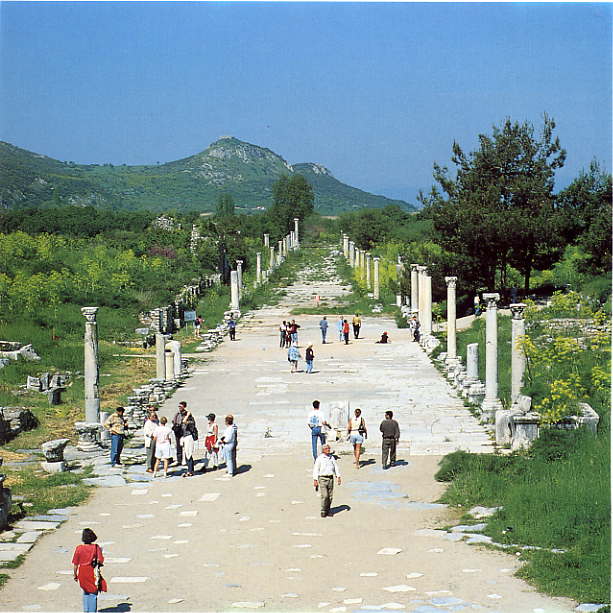
Tradition from several 2nd century sources (according to the Catholic Encyclopedia) state that John died in Ephesus, and his tomb is supposedly located on Ayosolug Hill. A small basilica was built over it in the 4th century, and Justinian replaced this with a larger basilica in the 6th century. My guide book appears not to have been translated too well, but it alludes to a holy well nearby, around or in which coins have been found dated to the second half of the first century. The Church of St John was within a stone’s throw of the mighty Temple of Artemis. The pic here shows a column of the temple in the foreground; I think that on the higher ground to the left of the column is the church, with a later fortress higher up. The next pic shows the tomb of St John. It has or had five satellite tombs, arranged in a cross shape.
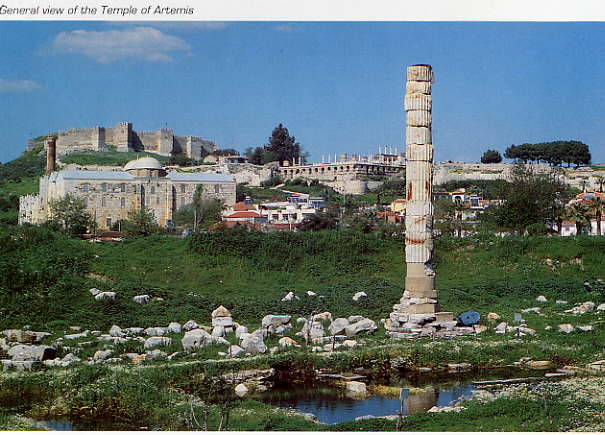
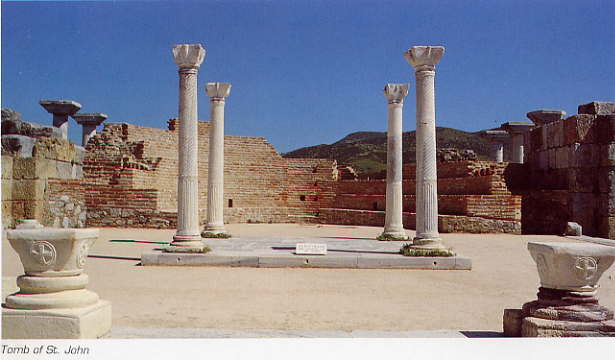
Tradition also had it that John was accompanied to Ephesus by Mary Magdalene and the BVM (Blessed Virgin Mary). Mary Magdalene was supposed to have died there, and in 899 her relics were transferred from Ephesus to Constantinople by Leo the Wise. This is in contradiction, of course, to the French tradition which has Magdalene and Lazarus move to Marseilles.
As far as the BVM is concerned, Ephesus claimed to be her first cult-centre, but her tomb was always held to be near Jerusalem. There is an interesting questing story which changed this however. Somewhere between 1822 and 1824 a Bavarian nun called Catherine Emmerich went into trance and saw the location of the house of the BVM. Despite never having left Germany she described the location of the house, stating that it was a little distance from the main city and that from it you could see the Agean Sea and the road leading to the Church of St Mary (situated very close to Harbour Street, which might be our straight street). She seems also to have predicted the finding of ash in a fireplace. In 1892 two priests, Mr Poulain and Mr Young, went to investigate and after a search found the house in the situation as described on Bulbul Dag, complete with ash in the fireplace. Unfortunatley they didn’t find the grave of the BVM, which Catherine Emmerich had said was less than 500m from the house. There is a fountain of Mary there as well, reputed to have healing powers, as is the ash in the fireplace in Mary’s house. Here are some pics of the house, outside and inside:
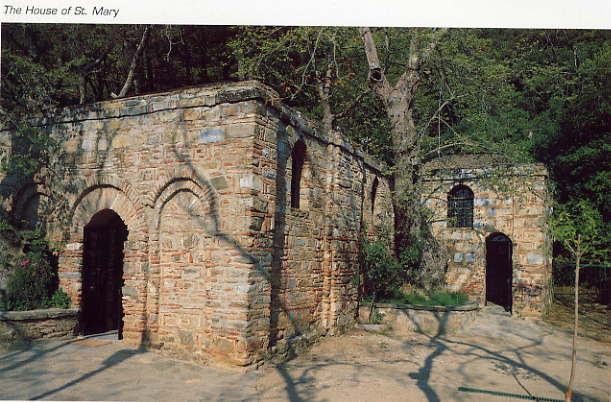
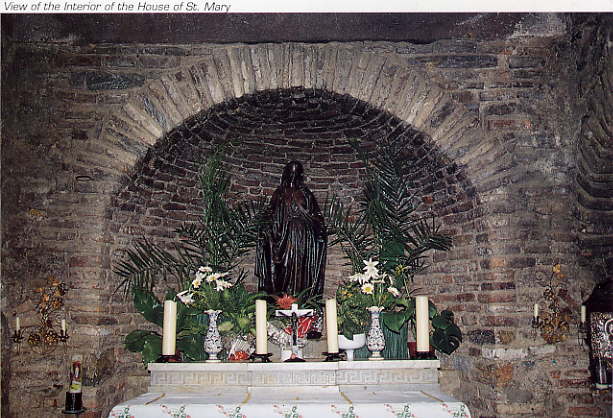
Michael
May 8, 2006 at 3:42 pm #2139While back at my parents’ house last month, I saw a book in a bookshelf on mystics and psychics that I hadn’t seen before (unusual in itself!). Leafing through it I came across a medium called Geraldine Cummins who had been something of a sesnation back at the middle of the last century. She channeled early christian entities (Philip the Evangelist and Cleophas) and published the result of this automatic writing in a number of volumes. It caught my eye that one was called "The Great Days of Ephesus". Although this is usually not my kind of thing at all, I decided to see if there was any material in the book that could help me with the Ephesus side of the quest.
I tracked down a secondhand copy on Amazon and when it arrived, I was initially dismayed to see that it was all about Paul in Ephesus – not John. However I later realised that the very last entry in the book (Appendix II) was about John and here she distinguished between three Johns: John the Apostle who had died in Jerusalem; John the elder who had written John’s Gospel in Ephesus; and John of Patmos who wrote the Book of Revelations.
I must admit that I hadn’t heard this theory before and it seemed obviously incorrect. I decided to consult Raymond Brown’s very sober and conservative book on New Testament Studies (it bears the imprimatur of the Catholic Church, so is dogmatically sanctioned and acts as a good yardstick against to measure some of the freakier theories that abound). Much to my surprise, in a footnote on the chapter on the authorship of the fourth Gospel, Brown cites ME Boismard as having recently collated evidence to suggest that the original John stayed in Judea and was distinct from the John in Ephesus.
Michael (Supernaturalist) then did some amazing research and found translations/book reviews of Boismard’s work which fleshed this out – and contained the additional fact that Boismard was convinced that the original John was Lazarus!
This brings the story full circle in an amazing way. The information produced by the two psychics (Joa Bolendas and Geraldine Cummins) thus appears to check out 100% against the latest (yet conservative) research.
From the point of view of the above quest, if Joa Bolendas is correct in saying that John was Lazarus then we may start to trust her more when she says that there is a cahe of as yet undiscovered material in Ephesus (presumably source material written by John/Lazarus but brought to Ephesus by the second John).
Certain clues have already emerged which might point the way to the next stage in discovering these writings but these will have to wait for a little while longer…
May 9, 2006 at 9:24 am #2140Just thought I’d add this to clarify Boismard’s theory:
Boismard and his close colleague Lamouille think, on the basis of an enormous textual study, that the earliest version of “John’s” gospel was written circa 50 C.E. in Palestine by Lazarus. This was expanded by ‘John II’ (aka John the Presbyter, author of the Johannine epsitles), who wrote two versions of the gospel, one in Palestine and a second many years later in Ephesus. A ‘John III’, who is unknown, then reworked the two John II gospels in the second century to give the final text. In the late second century Irenaeus confused John the Presbyter with John the apostle, resulting in the gospel being attributed to the latter.
So I suppose we might actually have five “John’s” altogether: (1) John the apostle, who doesn’t write anything: (2) Lazarus, who writes the original version of the Gospel of John as the ‘beloved disciple’: (3) John the Presbyter, who ends up in Ephesus and fleshes out the Lazarus material: (4) ‘John III’, whose identity is unknown, but is probably a Jewish Christian, and who redacts the final text: (5) John of Patmos, who writes the Apocalypse in the late first century, and is presumably unconnected with this particular quest. Phew!
Michael
May 9, 2006 at 9:35 am #2141Thanks for that, Michael.
And just to up the ante, Geraldine Cummins also claims that:
(i) John2 (aka Lazarus) died in the siege of Jerusalem; and
(ii) that John3 was John2′s son.Not sure how provable either of these two claims are but it would be interesting to see if anyone can point to evidence either for or against these views.
March 17, 2009 at 11:59 am #2535I was listening to an Aeon Byte podcast (http://www.thegodabovegod.com/ late yesterday. The guest was April De Conick, professor of Biblical Studies at Rice University, talking about the Gospel of John. She also thinks that Lazarus is the beloved disciple, for the reasons outlined in your article. Thought you’d like to know!
Michael
-
AuthorPosts
You must be logged in to reply to this topic.
